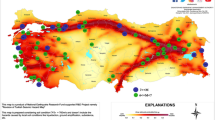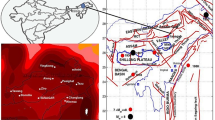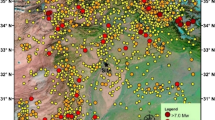Abstract
An earthquake-resistant design should include the effect of local site conditions on the seismic ground motions. In this study, ground response analyses in 22 locations around the developing town of Saruhanlı in the Aegean Region of Turkey were undertaken using SHAKE software. The ground response analyses for a typical soil profile considered various modulus reduction and damping curves including effective confining stress and a plasticity index dependent model. The confining stress-dependent soil models and shear-wave velocity profile resulted in higher amplification ratios and lower predominant periods. High acceleration ratios (>3) and lower predominant site periods were found in the eastern part of the site such that buildings of ten or more storeys would be severely damaged.
Résumé
La conception d’ouvrages résistant aux séismes devrait prendre en compte les effets de site sur le mouvement sismique. Dans cette étude, les analyses de réponse du sol en 22 endroits autour de la ville en développement de Saruhanlı, dans la région égéenne de la Turquie, ont été réalisées en utilisant le logiciel Shake. Les analyses de réponse du sol pour un profil typique de sol ont pris en compte diverses réductions des modules de déformation et des courbes d’amortissement alimentant un modèle dépendant de la pression de confinement effective et de l’indice de plasticité. Les modèles de sols dépendant de la pression de confinement et la prise en compte de profils de vitesse des ondes de cisaillement ont conduit à mettre en évidence des rapports d’amplification élevés et des périodes principales plus faibles. Des rapports d’accélération élevés (>3) et des périodes principales plus faibles ont été obtenus dans la partie est du site, conduisant au constat que des immeubles de 10 étages ou plus seraient sérieusement endommagés.

















Similar content being viewed by others
References
Aydan O (1997) The seismic characteristics and the occurrence pattern of Turkish earthquakes. Turkish Earthquake Foundation Report No.TDV/TR 97-007
Bayulke N (1978) Behavior of brick masonry structures during earthquakes. Deprem Arastirma Enstitusu Bulteni 22:26–41 (in Turkish)
Borcherd RD (1994) Estimates of site dependent response spectra for design (methodology and justification). Earthq Spectra 10:617–654
Ciftci NB, Bozkurt E (2008) Pattern of normal faulting in the Gediz Graben, SW Turkey. Tectonophysics. doi:10.1016/j.tecto.2008.05.036
Ciftci NB, Bozkurt E (2009) Evolution of the Miocene sedimentary fill of the Gediz Graben, SW Turkey. Sed Geol 126:49–79
Darendeli MB (2001) Development of a new family of normalized modulus reduction and material damping curves. PhD Dissertation, The University of Texas at Austin
Darendeli MB, Stokoe KH, Rathje EM, Roblee C (2001) Importance of confining pressure on nonlinear soil behaviour and its impact on earthquake response predictions of deep sites. In: XVth International Conference on soil mechanics and geotechnical Engineering, Istanbul, Turkey, pp 2811–2814
Dobry R, Borcherd RD, Crouse CB, Idriss IM, Joyner WB, Martin GR, Power MS, Rinne EE, Seed RB (2000) New site coefficient and site classification system used in recent building code provisions. Earthq Spectra 16:41–67
Durukal E, Erdik M, Avci J, Yuzugullu O, Alpay Y, Avar B, Zulfikar C, Biro T, Mert A (1998) Analysis of the strong ground motion data of the 1995 Dinar, Turkey earthquake. Soil Dyn Earthq Eng 17:557–578
Earthquake Regulations of Turkey (2007) Regulations for buildings to be constructed in disaster zones. General Directorate of Disaster Affairs (in Turkish)
Hardin BO, Drnevich VP (1972) Shear modulus and damping of soils, measurement and parameter effects. J Soil Mech Found Div 98:667–692
Hasancebi N, Ulusay R (2006) Evaluation of the site amplification and site period using different methods for an earthquake-prone settlement in Western Turkey. Eng Geol 87:85–104
Idriss IM, Sun JI (1993) User’s manual for SHAKE91: a computer program for conducting equivalent linear seismic response analyses of horizontally layered soil deposits. Center for Geotechnical Modeling, Department of Civil and Environment
Iller Bankasi (2006) Geological and geotechnical report of the sites requiring detailed geotechnical investigations for the town planning of Saruhanli (Manisa) municipality. ILB-I/45-039-004, Ankara (in Turkish)
Ishibashi I, Zhang XJ (1993) Unified dynamic shear moduli and damping ratios of sand and clay. Soils Found 33:182–191
Iwasaki T, Tatsuoka F, Takagi Y (1978) Shear modulus of sands under torsional shear loading. Soils Found 18:39–56
Kokusho T (1980) Cyclic triaxial test of dynamic soil properties for wide strain range. Soils Found 20:45–60
Kramer SL (1996) Geotechnical earthquake engineering. Prentice Hall, USA
Metli F, Tan T, Baykul A, Akalin H L, Avsar M, Turkbilegi H, Sun A, Saygili N, Isin R (2001) Environment geology and area usage potential of Manisa city and its vicinity. Geological Investigations Department, Ankara, MTA, no. 10480 (in Turkish)
Robertson PK (1990) Soil classification using the cone penetration test. Can Geotech J 27:151–158
Robertson PK, Woeller DJ, Finn WDL (1992) Seismic cone penetration test for evaluating liquefaction potential. J Soil Mech Found Div 29:686–695
Sari C (2003) Inversion of gravity data using singular value decomposition technique and determination of the sediment thicknesses of the Gediz and Buyuk Menderes Grabens. DEÜ Mühendislik Fakültesi Fen ve Mühendislik Dergisi 5:121–135 (in Tukish)
Sayisal Grafik (2009) http://www.sayisalgrafik.com.tr/deprem/tr_frames.htm. Accessed 12 May 2009
Schnabel PB, Lysmer J, Seed HB (1972) SHAKE: a computer program for earthquake response analysis of horizontally layered sites. Report No. UCB/EERC—72/12, University of California, Berkeley, USA
Seed HB, Idriss IM (1970) Soil moduli and damping factors for dynamic response analysis. Report No. EERC 70-10, University of California, Berkeley, USA
Sengor AMC, Yilmaz Y, Sungurlu O (1984) Tectonics of the Mediterranean Cimmerides: nature and evolution of the western termination of Paleo-Tethys. In: Dixon JE, Robertsen AHF (eds) The geological evolution of the Eastern Mediterranean. Special Publication, Geological Society, London 17, pp 77–112
Spudich P, Fletcher JB, Hellweg M, Boatright J, Sullivan C, Joyner WB, Hanks TC, Boore DM, McGarr A, Baker LM, Lindth AG (1997) SEA96—a new predictive relation for earthquake ground motions in extensional techtonic regimes. Seismol Res Lett 68:190–199
Spudich P, Joyner WB, Lindh AG, Boore DM, Margaris BM, Fletcher JB (1999) SEA99: a revised ground motion prediction relation for use in extensional tectonic regimes. Bull Seismol Soc Am 80:1156–1170
Sun JI, Golesorkhi R, Seed HB (1988) Dynamic moduli and damping ratios for cohesive soils. Report No. EERC 88-15, University of California, Berkeley
Tezcan SS, Kaya E, Bal IE, Ozdemir Z (2002) Seismic amplification at Avcilar, Istanbul. Eng Struct 24:661–667
Ulusay E, Tuncay E, Sonmez H, Gokceoglu C (2004) An attenuation relationship based on Turkish strong motion data and iso-acceleration map of Turkey. Eng Geol 74:265–291
Ventura CE, Onur T, Hao KX-S (2004) Site period estimations in the Fraiser River Delta using microtremor measurements—experimental and analytical studies. In: 13th World Conference on earthquake engineering, Vancouver, B.C., Canada, Paper No: 1075
Vucetic M, Dobry R (1991) Effect of soil plasticity on cyclic response. J Geotech Eng 117:89–107
Zhang J, Andrus RD, Juang CH (2005) Normalized shear modulus and material damping ratio relationships. J Geotech Geoenviron Eng 131:453–464
Acknowledgments
The author would like to express his gratitude to the Iller Bankasi staff: Ismail Bulut, Murat Saglam, Candan Uckardesler and Zafer Sal for field work information.
Author information
Authors and Affiliations
Corresponding author
Rights and permissions
About this article
Cite this article
Işık, N.S. Assessment of the site amplifications and predominant site periods for Saruhanlı, in an earthquake-prone region of Turkey. Bull Eng Geol Environ 69, 309–319 (2010). https://doi.org/10.1007/s10064-010-0263-5
Received:
Accepted:
Published:
Issue Date:
DOI: https://doi.org/10.1007/s10064-010-0263-5




